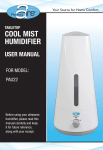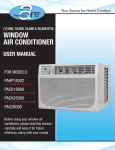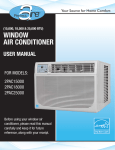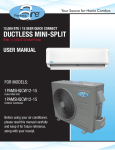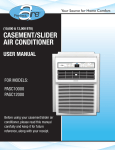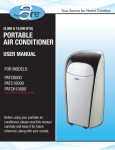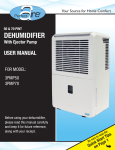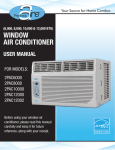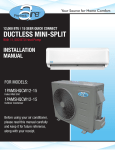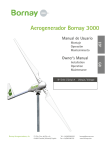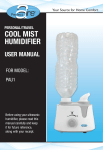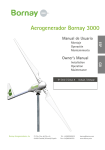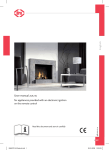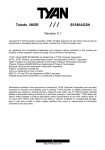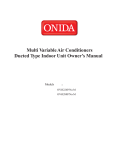Download WINDOW AIR CONDITIONER
Transcript
Your Source for Home Comfort (8,000, 11,000 & 12,000 BTU) WINDOW AIR CONDITIONER USER MANUAL FOR MODELS: 2PACH8000 with 3,500 BTU electric heater PACH12000 with 11,000 BTU electric heater PAHP12002 with 16,000 BTU heat pump Before using your window air conditioner, please read this manual carefully and keep it for future reference, along with your receipt. CONTENTS SAFETY PRECAUTIONS ..................................................................................... 2 IMPORTANT SAFETY INSTRUCTIONS .............................................................. 4 NORMAL SOUNDS .............................................................................................. 5 AIR CONDITIONER FEATURES..........................................................................6 INSTALLATION INSTRUCTIONS .........................................................................8 CARE AND CLEANING....................................................................................... 15 TROUBLESHOOTING TIPS ................................................................................ 16 This manual provides the information needed for proper use and maintenance of this air conditioner. Basic preventative care can help extend the life of this unit. The “Troubleshooting Tips” section in this manual contains a chart with solutions to the most common problems. Referring to this section may save time and prevent the need for a service call in the event of a problem. ! CAUTION ●Contact an authorized service technician for repair or maintenance of this unit. ●Contact an installer for installation of this unit if necessary. ●The air conditioner is not intended for use by young children without supervision. Young children should be supervised to ensure that they do not play with the air conditioner. ●Disabled persons may require assistance with set up. ●If the power cord is to be replaced, replacement work should be performed by authorized personnel only. ●Installation and repair work must be performed in accordance with the national wiring standards by authorized personnel only. ●Do not operate your air conditioner in a wet room such as a bathroom or laundry room. ●Units with a heating function should be at least 3 1/3 ft (1 meter) away from any combustible/ flammable materials. NOTE: All the illustrations in this manual are for explanation purposes only. Unit purchased may be slightly different. The design and specifications are subject to change without prior notice for product improvement. Contact customer service for details. 1 SAFETY PRECAUTIONS To prevent injury to the user or other people and property damage, the following instructions must be followed. Incorrect operation due to ignoring of instructions may cause harm or damage. The seriousness is classified by the following indications. ! ! WARNING ! CAUTION This symbol indicates the possibility of death or serious injury. This symbol indicates the possibility of injury or damage to property. Meanings of symbols used in this manual are as shown below. ! ! Never do this. Always do this. ! ! ! Plug in power plug properly. Do not operate or stop the unit by inserting or pulling out the power plug directly from the wall. Failure to do so may cause electric shock or fire due to excess heat generation. Doing so may cause electric shock or fire due to heat generation. Do not modify power cord length or share the outlet with other appliances. Do not operate with wet hands or in damp environment. Do not direct airflow directly at room occupants. Always ensure effective grounding. Do not allow water to run into electric parts. ! grounding may cause electric shock. Doing so may cause failure of machine or electric shock. Incorrect installation may cause fire and electric shock. Always unplug the unit if strange sounds, smell or smoke comes from the unit. Do not use the socket if it is loose or damaged. ! Failure to do so may cause fire and electric shock. ! Doing so may cause fire. This could cause health issues. Always install circuit breaker and a dedicated power circuit. Do not open the unit during operation. Doing so may cause fire and electric shock. Doing so may cause electric shock. Do not use the power cord close to heating appliances. Do not disassemble, modify, or drill holes into the air conditioner. Doing so may cause failure and electric shock. Do not use firearms near unit. ! Doing so may cause electric shock or fire. If the power cord is damaged, it must be replaced by the manufacturer or an authorized service center or a similarly qualified person in order to avoid a hazard. Doing so may cause electric shock. ! Incorrect ! Do not use a damaged power cord. so may cause electric shock or fire due to heat generation. ! Doing ! ! WARNING Doing so may cause fire and electric shock. Ventilate room before operating air conditioner if there is a gas leakage from another appliance such as a stove. Do not use the power cord near flammable gas or combustibles, such as gasoline, benzene, thinner, etc. Failure to do so may cause explosion, fire and burns. Doing so may cause an explosion or fire. 2 ! CAUTION ! ! When removing air filter, do not touch metal parts of the unit. Do not clean with water. Doing so may cause an injury. . Water may enter the unit and degrade the insulation causing an electric shock. Unit and Circuit breaker/fuse must be switched OFF when cleaning. Do not put a pet or house plant where it will be exposed to direct air flow. Cleaning unit when power is ON may cause fire and electric shock and may cause an injury. This could injure the pet or plant. Stop operation and close the window in severe storms or hurricanes. ! Operation with windows open may cause moisture to enter the room. Do not place obstacles around air-inlets or inside of air-outlet. ! Use only a soft cloth to clean the unit. Periodically check installation bracket for damage. . ! Cleaners or detergents may change the color or scratch the surface of the unit. Ensure proper ventilation especially in rooms with a stove or other appliances. Failure to do so may result in an oxygen shortage. ! Use only as intended. This unit is NOT intended to preserve precision devices, food, pets, plants, and art objects. It may cause deterioration of quality, etc. ! Failure to do so may cause electric shock and damage. Obstacles may cause appliance failure or accident. ! Hold the plug by the head of the power plug when taking it out. ! If unit will not be used for a long period of time, turn OFF main power switch. Leaving power on may cause unit failure or fire. ! Always insert the filters securely. Clean filter AT LEAST once every two weeks. Prolonged exposure to outdoor elements may cause damage to installation bracket causing unit to fall. Operation without secured filters may cause failure. A dirty filter can cause the unit to not run efficiently. Use caution when unpacking and installing. NEVER drink water drained from air conditioner. Sharp edges could cause injury. Water from unit contains contaminants and could cause illness. Do not place heavy objects on the power cord and always ensure that the cord is not compressed. ! There is danger of fire or electric shock. If water enters the unit, turn the unit off at the power outlet and switch off the circuit breaker. Isolate supply by taking the power-plug out and contact a qualified serviced technician. There is danger of electric shock. Meeting Electrical Requirements ! WARNING Observe all local governing codes and ordinances. Electrical Shock and Personal Injury Hazard Do not, under any circumstances, remove the power supply cord grounding prong. • Electrical ground is required on this appliance. • DO NOT ground to a gas line. • If cold water pipe is interrupted by using plastic, nonmetallic gaskets, or other insulating materials. DO NOT use for grounding. • Check with a qualified electrician if you are in doubt as to whether the appliance is properly grounded. • DO NOT modify power supply cord plug. If it does not fit the outlet, have a proper outlet installed by a qualified electrician. • DO NOT have a fuse in the neutral or grounding circuit. A fuse in the neutral, or grounding circuit could result in an electrical shock. • DO NOT use an extension cord with this appliance. Failure to follo w these instructions could result in electrical shock, serious injury, or death. NOTE: If codes permit, and a separate grounding wire is used, it is recommended that a qualified electrician determine that the grounding path is adequate and not interrupted by plastic, non-metallic gaskets, or other insulating materials. Receptacle Wiring Receptacle wiring should be a minimum of 14 gauge. Use copper wire only. It is your responsibility to provide proper and adequate receptacle wiring, installed by a qualified electrician. Electrical Requirements A time delay fuse or time delay circuit breaker is also required. A separate circuit, serving only this appliance, MUST be provided. 3 IMPORTANT SAFETY INSTRUCTIONS NOTE The power supply cord with this air conditioner contains a current detection device designed to reduce the risk of fire. Please refer to the section "Operation of Current Device" (below) for details. In the event that the power supply cord is damaged, it MUST be replaced by an authorized repairman. DO NOT, under any circumstances, cut, remove, or bypass grounding prong. Power supply cord with 3-prong grounding plug and current detection device WARNING! For Your Safety DO NOT store or use gasoline or other flammable vapors or liquids in the vicinity of this or any other appliance. Avoid fire hazard or electric shock. DO NOT use an extension cord or an adaptor plug. DO NOT remove any prong from the power cord. WARNING! Electrical Information Be sure the electrical service is adequate for the model you have chosen. This information can be found on the serial plate, which is located on the side of the cabinet and behind the grill. Be sure the air conditioner is properly grounded. To minimize shock and fire hazards, proper grounding is important. The power cord is equipped with a three-prong grounding plug for protection against shock hazards. Your air conditioner must be used in a properly grounded wall receptacle. If the wall receptacle you intend to use is not adequately grounded or protected by a time delay fuse or circuit breaker, have a qualified electrician install the proper receptacle. Ensure the receptacle is accessible after the unit installation. Do not run air conditioner without side protective cover in place. This could result in mechanical damage within the air conditioner. Do not use an extension cord or an adaptor plug. Operation of Current Device The power supply cord contains a current device that senses damage to the power cord. To test your power supply cord do the following: Plug in & press RESET TEST RESET 1. Plug in the air conditioner. 2. The power supply cord will have TWO buttons on the plug head. Press the TEST button. The RESET button will click as it pops out. 3. Press the RESET button; again you will notice a click as the button engages. 4. The power supply cord is now supplying electricity to the unit. (On some products this is also indicated by a light on the plug head.) NOTE: Some plugs have buttons on the top. NOTES: Do not use this device to turn the unit on or off. Always make sure the RESET button is pushed in for correct operation. The power supply must be replaced if it fails to reset when either the TEST button is pushed or it cannot be reset. If power supply cord is damaged, it cannot be repaired. Please call customer service to assist with replacement. NOTE: This air conditioner is designed to be operated under conditions as follows: Cooling operation Heating operation Outdoor temp: 18-43°C/64-109°F (18-52°C/64-125°F for special tropical models) Indoor temp: 17-32°C/62-90°F Outdoor temp: -5-24°C/23-76°F Indoor temp: 0-27°C/32-80°F *Please note that not all units come with a heating element. The “Heating operation” specifications only apply for units that DO have a heating element. If the unit is operated beyond the conditions specified above, it may cause a failure of the unit. 4 NORMAL SOUNDS High Pitched Chatter High efficiency compressors may have a high pitched chatter during the cooling cycle. Vibration Unit may vibrate and make noise because of poor wall or window construction or incorrect installation. Sound of Rushing Air At the front of the unit, you may hear the sound of rushing air being moved by the fan. Pinging or Switching Droplets of water hitting condenser during normal operation may cause “pinging” or “switching” sounds. Gurgle/Hiss “Gurgling” or “hissing” noise may be heard due to refrigerant passing through evaporator during normal operation. NOTE: This illustration is for explanation purposes only. The actual appearance of the control panel on the air conditioner purchased may be sightly different. AIR CONDITIONER FEATURES ELECTRONIC CONTROL OPERATING INSTRUCTIONS Before you begin, thoroughly familiarize yourself with the control panel as shown below and all its functions. Then, follow the symbol for the functions you desire. The unit can be controlled by the unit controls alone or with the remote control. TEMP/TIMER Energy Saver Auto Cool Dry Mode Fan TEMP/TIMER On Off Sleep Fan Timer TO TURN UNIT ON OR OFF: Check Filter Follow Me Press Auto High Med Low (Cooling Only Models) REMOTE SIGNAL RECEPTOR TO CHANGE TEMPERATURE SETTING: Press / UP/DOWN button to change the temperature setting. TEMP/TIMER Energy Saver Auto Cool Dry Heat Mode Fan TEMP/TIMER On Off ON/OFF button to turn the unit on or off. NOTE: The unit will automatically initiate the Energy Saver function under “Cool,” “Dry” and “Auto” (only Auto-Cooling and Auto-Fan) modes. Sleep Fan Timer NOTE:Press or hold either UP( ) or DOWN ( ) button until the desired temperature is seen on the display. This temperature will be automatically maintained anywhere between 62 OF(17 OC) and 86 OF(30 OC). If you want the display to read the actual room temperature, see “To Operate on Fan Only” section. Check Filter Follow Me Auto High Med Low (Electric Heater & Heat Pump Models) UNIT CONTROL 5 AIR CONDITIONER FEATURES (CONTINUED) TO ADJUST THE FAN SPEED: TO SELECT THE OPERATING MODE: Press to select one of four fan speeds: “Auto,” “Low,” “Med” or “High.” Each time the button is pressed, the fan speed mode is shifted. On “Dry” mode the fan speed is set at low automatically. For some models with heating capabilities, the fan speed cannot be adjusted under “Heat” mode. To choose operating mode, press the Mode button. Each time you press the button, a mode is selected in a sequence that goes from “Auto,” “Cool,” “Dry,” “Heat,” (for units with heating function) and “Fan.” The indicator light will be illuminated and remain on once the mode is selected. The unit will automatically initiate the Energy Saver function under “Cool,” “Dry,” and “Auto” (only Auto-Cooling and AutoFan) modes. SLEEP FEATURE: Press Sleep button to initiate the sleep mode. In this mode the selected temperature will increase (cooling) or decrease (units with heating only) by 2 O F/ 1 O C 30 minutes after the mode is selected. The temperature will then increase (cooling) or decrease (units with heating only) by another 2 O F/1 O C after an additional 30 minutes. This new temperature will be maintained for 6 hours before it returns to the originally selected temperature. This ends the Sleep mode and the unit will continue to operate as originally programmed. The Sleep mode program can be cancelled at any time during operation by pressing the “Sleep” button again. CHECK FILTER FEATURE: Press Check Filter button to initiate this feature. This feature is a reminder to clean the Air Filter for more efficient operation. The LED (light) will illuminate after 250 hours of operation. To reset after cleaning the filter, press the “Check Filter” button and the light will go off. ENERGY SAVER FEATURE: Press Energy Saver button to initiate this function. This function is available on “Cool,” “Dry,” and “Auto” (only Auto-Cooling and Auto-Fan) modes. In this mode, the fan will continue to run for 3 minutes after the compressor shuts off.The fan then cycles on for 2 minutes, at 10 minute intervals, until the room temperature is above the set temperature, at which time the compressor turns back on and cooling starts. To operate on “Auto” feature: When you set the air conditioner in AUTO mode, it will automatically select cooling, heating (on models with heating capabilities), or fan only operation depending on what temperature you have selected and the room temperature.The air conditioner will control room temperature automatically around the temperature you set. In this mode, the fan speed cannot be adjusted. It starts automatically at a speed according to the room temperature. To operate on “Fan” only: (not available on all models) Use this function only when cooling is not desired, such as for room air circulation or to exhaust stale air. (Remember to open the vent during this function, but keep it closed during cooling for maximum cooling efficiency.) You can choose any fan speed you prefer. During this function, the display will show the actual room temperature, not the set temperature as in the cooling mode. To operate on “Dry” mode: In this mode, the air conditioner will reduce air humidity. If the space is a closed or sealed area, some degree of cooling will continue. TIMER: AUTO START/STOP FEATURE: When the unit is on or off, first press Timer button. The TIMER ON indicator light illuminates. It indicates the Auto Start program is initiated. When the time of TIMER ON is displayed, if you pres the Timer button again, the TIMER OFF indicator light illuminates. It indicates the Auto Stop program is initiated. Press or hold the UP or DOWN button to change the Auto time by 0.5 hour increments, up to 10 hours, then by 1 hour increments, up to 24 hours. The control will count down the time remaining until start. The selected time will register in 5 seconds and the system will automatically revert back to display the previous temperature setting or the room temperature (depending on whether the unit is powered on or off and the mode it is in). Turning the unit ON or OFF at any time or adjusting the timer setting to 0.0 will cancel the Auto Start/Stop program. FOLLOW ME FEATURE: Follow Me Light flashing This feature can ONLY be activated from the remote control. The remote control serves as a remote thermostat allowing for precise temperature control at its location. To activate the Follow Me feature, point the remote control towards the unit and press the “Follow Me” button. The remote displays the actual temperature at its location. The remote control will send this signal to the air conditioner every 3 minutes until the Follow Me button is pressed again. If the unit does not receive the Follow Me signal during any 7 minute interval, the unit will beep to indicate the Follow Me mode has ended. The actual temperature can be displayed at the unit by pressing the “Fan” only mode. When in the “Cool” mode, the unit display indicates the set temperature. 6 AIR CONDITIONER FEATURES (CONTINUED) DISPLAYS Displays Error Codes: AS - Room temperature sensor error - Unplug the unit and plug it back in. If error repeats, call customer service. Shows the set temperature in “°C” or “°F” and the Auto-timer settings. While on “Fan” only mode, it shows the room temperature. NOTE: If the unit breaks off unexpectedly due to power being cut, it will restart with the previous function setting automatically when the power resumes. HS - Electric heating sensor error - Unplug the unit and plug it back in. If error repeats, call customer service. - Evaporator temperature sensor error - Unplug the unit and plug it back in. If error repeats, call customer service. (“ ” is displayed in the above picture.) NOTE: In “Fan” only mode, unit will display “Lo” or “Hi”. ADDITIONAL THINGS YOU SHOULD KNOW The Cool circuit has an automatic 3 minute time delayed start if the unit is turned off and on quickly. After unit is turned off, leave unit off for a minimum of 3 minutes before attempting to turn back on. This prevents overheating of the compressor and possible circuit breaker tripping. The fan will continue to run during this time. The control is capable of displaying temperature in degrees Fahrenheit or degrees Celsius. To convert from one to the other, press and hold the Up and Down Temp/Timer buttons at the same time, for 3 seconds. Air Directional Louvers HOW TO USE: Use the 4-way directional louvers to direct the air flow Up or Down and Left or Right throughout the room as needed. Pivot horizontal louvers until the desired Up/ Down direction is obtained. Move the Center Handles from side to side until the desired Left/Right direction is obtained. Air Direction (4- way) Fresh Air Vent Control (on some models): Figure A (VENT CLOSED) Figure B (VENT OPEN) Figure C (VENT & EXHAUST OPEN) The Fresh Air Vent allows the air conditioner to: 1. Recirculate inside air - Vent Closed (See Fig.A) 2. Draw fresh air into the room - Vent Open (see Fig.B) 3. Exchange air from the room and draw fresh air into the room - Vent and Exhaust Open (see Fig. C) 7 INSTALLATION INSTRUCTIONS ! CAUTION To avoid risk of personal injury, property damage, or product damage due to the weight of this unit and sharp edges that may be exposed, please note the following: • Air conditioners covered in this manual pose an excessive weight hazard. Two or more people are needed to move and install the unit. To prevent injury or strain, use proper lifting and carrying techniques when moving unit. • Carefully inspect location where air conditioner will be installed. Be sure it will support the weight of the unit. • Handle air conditioner with care. Wear protective gloves whenever lifting or carrying the unit. AVOID the sharp metal fins of front and rear coils. • Use extra caution to ensure that air conditioner does not fall during installation. TOOLS AND PARTS: Gather the required tools and parts before starting installation. Read and follow the instructions provided with any tools listed here. TOOLS NEEDED Flat-blade and Phillips screwdrivers Tape measure Level Drill and 3/16″, 1/8″, 3/32″, or smaller drill bit Through-the-Wall Installation: In addition to the tools listed above, the following tools are also needed for through-the-wall installation. TOOLS NEEDED Saw Caulk 1″ (2.5 cm) or thicker lumber #10 x 1″ wood screws (7) PARTS SUPPLIED: Check that all parts are included in parts package. Hardware Qty. Hardware #10 x 1/2″ Pan-Head Phillips Screws 3 Top Channel 1 #10 x 3/4″ or #10 x 1/2″ Round-Head Screws 7 Window Sash Seal 1 #10 x 1/4″ Pan-Head Phillips Screws 5 Foam Seal 1 Window Lock Bracket 1 Safety Lock (for vinyl-clad window) 2 Weather Seats (6″ x 3/4″ x 1/12″) 5 Remote Battery 2 Side Curtains LED SLEEP RESET LOCK TIMER CLOCK CANCEL FAN MODE CLEAN AIR ENERGY SAVER FOLLOW ME F CLO CK ON OFF AUT O SETTEMP. E 2 FAN SPEED Qty. Remote Control 1 8 INSTALLATION INSTRUCTIONS Note: Installation parts are supplied for double-hung windows up to 36″ (91.4 cm) wide. A special Wide Window Kit is available from your dealer or service center. See “Accessories.” Do not use any screws other than those specified here. Do not use an extension cord. Cabinet louvers must not be obstructed. Air must be able to pass freely through the cabinet louvers. (Fig.1) Location Requirements: IMPORTANT: Observe all governing codes and ordinances. Check the location where air conditioner will be installed. Proper installation is your responsiblity. Make sure you have everything necessary for correct installation. Grounded electrical outlet within 4 ft (122 cm) of where the power cord exits the air conditioner. Free movement of air in room to be cooled. A large enough opening for the air conditioner. Adequate wall support for weight of air conditioner. Air conditioner weighs between 70 and 85 lbs (32 to 40 kgs). Window Installation: Window opening measurements (FIG. 2): 26-7/8″ to 36″ (68.3 cm to 91.4 cm) opening width. 16-1/2″ (41.9 cm) minimum opening height. FIG. 2 FIG. 1 A. Cabinet louvers Remove packaging material: Remove and dispose of/recycle packaging materials. Remove tape and glue residue from surfaces before installing the air conditioner. Rub a small amount of liquid soap over the adhesive with your fingers. Wipe with warm water and dry. Do not use sharp instruments, rubbing alcohol, flammable fluids, or abrasive cleaners to remove tape or glue. These products can damage the surface of your air conditioner. Handle the air conditioner gently. 1. Remove the air conditioner from the carton and place it on cardboard. 2. Remove 1 shipping screw from each side of the cabinet (FIG 3). 3. Remove front panel by removing 1 Phillips screw from each side of the front panel. Set screws aside and save (FIG. 4). 4. Pull on the handles to slide the air conditioner out of the cabinet. Place the air conditioner on cardboard (FIG. 5). 9 INSTALLATION INSTRUCTIONS FIG. 3 FIG. 4 FIG. 5 B C Note: B A • Handle the air conditioner gently. • Be sure your air conditioner cabinet does not fall out of the opening during installation or removal. • The place where the power cord exits the air conditioner should be no more than 4 ft (122 cm) from a grounded 3 prong outlet. • Do not block the louvers on the front panel. • Do not block the louvers on the outside of air conditioner. • Do not lift, pull or remove any expanded polystyrene (foam) from inside of the air conditioner. It is NOT packing material. FIG. 6 Attach Top Channel: Attach the top channel and side curtains to the air conditioner cabinet before placing the cabinet in the window. (FIG. 6) A B O 1. Locate provided bag of screws. 2. Place the top channel on top of the air conditioner cabinet, lining up the three holes in the top channel with the three holes on top of the air conditioner cabinet. Attach Side Curtains: 1. Locate provided bag of screws. 2. Insert the right-hand curtain connector tab into the curtain housing channels on the air conditioner (FIG. 7A). 3. Insert the top and then bottom of the right-hand curtain housing in the top and bottom curtain channels on the air conditioner (FIG. 7B, FIG. 7C). 4. Slide the curtain housing into the curtain guides as far as it can go. 5. Repeat the above steps for the left-hand curtain. FIG. 7A FIG. 7B - Top View A A FIG. 7C - Bottom View B A A. Side curtain A. Curtain housing B. Curtain top channel on air conditioner 10 B A. Curtain housing B. Curtain bottom channel INSTALLATION INSTRUCTIONS Attach foam adhesive seal: Attach foam adhesive seal along the bottom of the curtain bottom channel (FIG. 8). FIG. 8 FIG. 9 A Window Inner Sill B A. Curtain housing B. Foam adhesive seal FIG. 10 Angle of cabinet bracket securely seated on edge of inner sill. A B C Cabinet Bracket Window Outer Sill A. Window sash B. Empty cabinet C. Window channel Install Cabinet into Window: 1. Center empty cabinet in window: Check that lower rail of air conditioner cabinet is behind and against back side of window sill. Maintain a firm hold on the air conditioner cabinet (FIG. 9). Lower window sash to hold the cabinet in place. Measure the distance between the right side of the cabinet and the inside of the window channel (FIG. 10). Repeat for the left side. Adjust the cabinet until the distance on each side is the same. 2. Attach the cabinet to window: A: For wooden windows: Use a 3/16″ drill bit to drill three starter holes 3/8” deep through the three holes in the cabinet and into the window sill, and drill one starter hole 3/8″ deep through the hole in the middle of top rail and into the window frame (FIG. 11). Attach cabinet to window with three #10 x 1/2″ pan-head Phillips screws and one #10 x 3/4″ or (1/2″) round-head screw (FIG. 11). B: For Vinyl-Clad windows: Use a 1/8″ drill bit to drill one hole through the hole in the middle of top rail and into the window frame. Attach cabinet to window with one #10 x 3/4″ or (1/2″) round-head Phillips screw (FIG. 11). Place two safety locks into the holes located in the bottom of the cabinet as shown (FIG. 12). 3. Check that the air conditioner cabinet is tilted back 5/16” to 3/8” so that water can run to the outside (FIG. 13). FIG. 13 FIG. 11 Window Sash FIG. 12 B A C A B Side Louvers A A A. #10 x 1/2″ pan-head Phillips screws B. #10 x 3/4″ (or 1/2″) round-head screw C. Window channel Window Sill A. #10 x 1/4″ Pan-head Phillips screws B. Safety Lock Only for vinyl-clad windows 11 INSTALLATION INSTRUCTIONS Attach Side Curtains to Window Frame: 1. Extend the side curtains out against the window frame (FIG. 11/page. 13). 2. Drill holes and drive locking screws: A: For wooden windows: Use a 3/32″ drill bit to drill 4 starter holes through the holes in the side curtains into the window. Drive four #10 x 3/4″ or (1/2”) locking screws through the holes in the side curtains into the window sill and window frame (FIG. 14A, FIG. 14B). B: For Vinyl-Clad windows: Use an 1/8″ drill bit to drill two holes through the holes in the side curtains into the window frame as shown (FIG. 14A). Drive two #10 x 3/4″ or (1/2″) locking screws through the holes in the side curtains into the window sash (FIG. 14A). 3. Trim the weather seal (6″ x 3/4″ x 1/12″) with proper length, peel off the protective backing and plug any gaps if needed as shown (FIG. 14B). FIG. 14A FIG. 14B A A B B C A. Window channel B. Left-hand curtain C. #10 x 3/4″ (or 1/2″) round-head screw A. #10 x 3/4″ (or 1/2″) round-head screw B. Slotted hole in the bottom of the curtain Complete Installation: 1. Insert window sash seal behind the top of the lower window sash and against the glass of the upper window (FIG. 15). 2. Place the window-lock bracket on top of lower window and against upper window sash on right side of the window (FIG. 15). 3. Use a 3/32″ drill bit to drill starter holes through the holes in the bracket into the window sash (FIG. 15). 4. Attach the window lock-bracket to the window sash with two #10 x 3/4″ or (1/2″) round-head screws to secure window in place (FIG. 15). 5. Insert air conditioner into cabinet (FIG. 16). FIG. 15 6. Insert front tabs of front panel into top of cabinet and swing B C front into place. A 7. Attach bottom front of panel with front panel screws (FIG. 17). 8. Plug into a grounded 3 prong outlet. 9. Press RESET on the power supply cord. D FIG. 16 FIG. 17 A. Window lock bracket B. Upper window glass C. Window sash seal D. #10 x 3/4″ or (1/2)″ round-head screws 12 INSTALLATION INSTRUCTIONS Through-the-Wall Cabinet Installation: FIG. 18 A B C Option 1- Wood, Metal or Plastic Molding When using a wood, metal or plastic molding, the wood frame should line up with the inside wall. D Option 2- Plastered wall with no molding (FIG. 18): If the plastered wall is to be flush with the cabinet and no molding is used, the wood frame must be set 1/2″ (13 mm) into the inside wall. (FIG. 19) A. Moulding B. Inside Wall C. Wood Frame D. Louvers Install Wood Frame: 1. Construct the wood frame. See FIG. 20 for dimensions. 2. Measure the outside width and height of frame to determine wall opening dimensions. The wall measurements should be: AB FIG. 19 C D Width: 22-5/8″ (57.5 cm) plus twice thickness of wood used to build frame. Height: 16″ (40.6 cm) plus twice thickness of wood used to build frame. Depth: 2-1/2″ (6.4 cm) minimum to 6-1/2″ (16.5 cm) maximum. 3. Cut the opening through the wall. Remove and save insulation. 4. Apply the wood preservative to the outside exposed surface. 5. Insert the frame in the wall opening. Square and level frame. 6. Attach frame securely to the wall. A. Plastered Wall B. Inside Wall Dimensions for depth depends on wall thickness and type of molding (FIG. 21). Do not block louvers in air conditioner cabinet. Use 1″ (2.5 cm) or thicker lumber for wood frame. C. Wood Frame D. Louvers C A B D C C. Wood thickness FIG. 21 A B C A. Outside width B. Outside height C. Depth 13 INSTALLATION INSTRUCTIONS Install Cabinet into Wood Frame: 1. Insert cabinet into the framed wall opening. The top of the cabinet should extend 3/4″ (19.1 mm) into the room. If there is trim, the cabinet should extend 3/4″ (19.1 mm) past trim (FIG. 22). 2. Use a level to check that cabinet is level side to side (FIG. 23). 3. Check that air conditioner cabinet is tilted to the outside so that water can run to the outside. The cabinet should slope at least half a bubble (on your level) towards the rear (FIG. 23). 4. Reuse the insulation to seal opening between cabinet and frame. 5. Use existing holes in sides and top of cabinet and seven #10 x 1″ wood screws (not provided) to attach cabinet to frame. 6. Caulk all outside wall openings around cabinet. Do not over tighen screws or the cabinet will distort and provide a poor air seal between cabinet and air conditioner. B A FIG.22 A. 3/4” (19.1 cm) extending into room B. Trim FIG.23 Level Complete Installation: 1. Insert air conditioner into cabinet (FIG . 24). 2. Insert front tabs of front panel into top of cabinet and swing front into place. 3. Attach bottom front of panel with front panel screws (FIG. 25). 4. Plug into a grounded 3 prong outlet. 5. Press RESET on the power supply cord. Handle the air conditioner gently. For through-the-wall installations, if needed, install molding around the room side of cabinet. FIG.24 FIG.25 NOTE: After installing, make sure the air conditioner is tilted 3-4° to the outside to allow water drainage and perfect cooling efficiency. 14 CARE AND CLEANING ! CAUTIONN Clean air conditioner occasionally to keep it looking and operating like new. Be sure to unplug the unit before cleaning to prevent shock or fire hazards. Air Filter Cleaning The air filter should be cleaned at least every two weeks or as necessary. Trapped particles in the filter can build up and cause an accumulation of frost on the cooling coils. Push the vent handle to the Vent Closed position (where applicable). Open the front panel. Grasp the filter by the center and pull up and out. Wash the filter using liquid dishwashing detergent and warm water. Rinse filter thoroughly. Gently shake excess water from the filter. Be sure the filter is thoroughly dry before replacing. As an alternative, vacuum the filter clean. NOTE: Never use hot water over 104 F (40 C) to clean the air filter. Never attempt to operate the unit without the air filter. Cabinet Cleaning Be sure to unplug the air conditioner to prevent shock or fire hazard. The cabinet and front may be dusted with an oil-free cloth or with a cloth dampened in a solution of warm water and mild liquid dishwashing detergent. Rinse thoroughly and wipe dry. Never use harsh cleaners, wax or polish on the cabinet front. Be sure to wring excess water from the cloth before wiping the controls. Excess water in or around the controls may cause damage to the air conditioner. Plug in air conditioner after unit has dried completely. Winter Storage If air conditioner will be stored during the winter, remove it carefully from the window according to the installation instructions. Cover it with plastic or return it to the original carton. Always store unit in upright position. 15 TROUBLESHOOTING TIPS Before calling for service, please review the chart below. Issue AIR CONDITIONER NOT COOLING ROOM, OR NOT BLOWING COLD AIR AIR CONDITIONER COOLING BUT ROOM IS TOO WARM - ICE FORMING ON COOLING COIL BEHIND DECORATIVE FRONT AIR CONDITIONER CYCLING ON AND OFF TOO FREQUENTLY OR NOT ENOUGH UNIT WILL NOT TURN ON UNIT BLOWS FUSES OR POPS CIRCUIT BREAKER AIR CONDITIONER IS MAKING NOISES Possible Solutions • Be sure unit is not too large or too small for the area of the room. • Verify that all doors, windows, curtains and any other openings are closed off. Verify nothing is obstructing the front grille of unit, such as curtains, etc. • Allow enough time for room to cool, especially if outside temp is very high. • Check that the filter is not dirty and louvers are open all the way and blowing in the direction desired. • Check that unit is set to Cool Mode and that temperature is down enough (but not too low). • If unit is near a heat source, such as a stove, etc., then relocate unit. • If air coming from unit is cool to the touch, then unit is working properly; please double check the first three bullet points above. • If using Follow Me remote feature, move remote away from unit. • Temperature sensor behind air filter touching cold coil. These two elements should not be touching. Carefully straighten tube away from coil. • Unplug unit for at least 5 minutes. Follow Reset instructions on plug. • Outdoor temperature is below 64ºF (18ºC). To defrost the coil, set to Fan Only mode. • Air filter may be dirty. Clean filter. Refer to Care and Cleaning section. To defrost, set to Fan Only mode. • Thermostat is set too cold for night-time cooling. To defrost the coil, set to Fan Only mode. Then, set temperature to a higher setting. • Be sure unit is not too large or too small for the area of the room. • Remove grille and make sure the temperature sensor is not too close to the coils. These two elements should not be touching. Carefully straighten tube away from coil. • Make sure nothing is blocking the grille or side vents. • Make sure there is no dirt or debris inside the unit or on the filter. • Reset circuit breaker. Make sure there are not too many items (ie lamps, TV’s, etc.) working off the same breaker. • Check plug connection. • If plug is operating on an on/off switch, be sure that the switch is ‘on’. • Try plugging unit into another outlet. • Unplug unit for at least 5 minutes. Follow Reset instructions on plug. • Make sure there are enough available amps on the circuit for the air conditioner. • Large units which run on a 230v will require a dedicated 20 or 30 amp circuit. • Check to be sure the unit is free from debris such as leaves, sticks, etc. Verify nothing is obstructing the unit. • Check the fan blade for cracks or chips. • Make sure the unit is properly and securely mounted inside the window or wall. • Clean the air filter. WATER PUDDLES INSIDE UNIT OR IS COMING INTO ROOM • Adjust the slope of the unit so that it drains downward toward the exterior of the home. (See Installation Instructions.) • Make sure that there is no debris blocking the drainage area of the unit. WATER DRIPPING OUTSIDE • Unit is removing a large quantity of moisture from a humid room. This is normal during excessively humid days. REMOTE SENSING / FOLLOW ME DEACTIVATING PREMATURELY • Remote control not located within range. Place remote control within 20 ft and 180º radius of the front of the unit. • Remote control signal obstructed. Remove obstruction. NOTE: A highly recommended troubleshoot for any issue in general consists of turning off unit and unplugging for 5 minutes. It is also recommended to try another wall outlet. 16 Your Source for Home Comfort Distributed by: Perfect Aire, LLC 5151 Belt Line Rd. Suite 878 Dallas, TX 75254 877-365-6274 www.perfectaire.us Specification and performance data is subject to change without notice. Printed in PRC


















